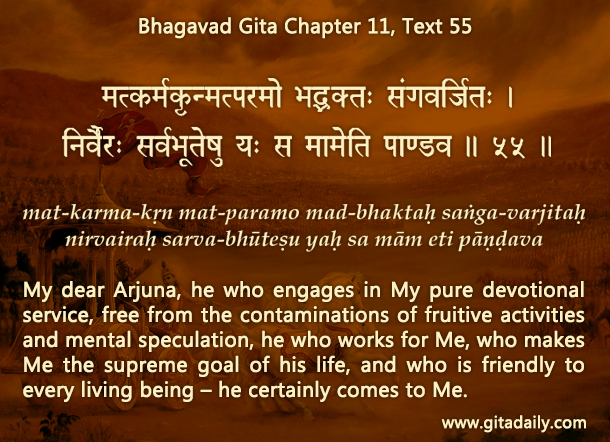Some people feel, “If I could see God, my faith would increase so much.” While beholding God externally can be special and thrilling, in our overall spiritual growth it is not necessarily the most important faith-boosting or life-defining experience, as we often imagine it to be.
The Mahabharata narrates how during the peace negotiations before the Kurukshetra war, Duryodhana beheld Krishna, not just in his two-handed form, but also in his universal form. And yet that awe-inspiring mystical vision, one of the most astonishing theophanies in world history, didn’t change Duryodhana’s anti-devotional disposition. Though he was indubitably overpowered and momentarily overwhelmed by that sight, he soon downplayed it as just a show of magic that would be inconsequential when the actual war would occur.
Of course, we as devotee-seekers don’t have that kind of anti-devotional disposition. So, let’s consider the example of the devotee Arjuna in the Bhagavad-gita. In the Gita’s eleventh chapter, Arjuna gets to behold an even more awesome display: the universal form combined with a vision of the kala-rupa, God manifested as time.
Yet, Arjuna’s conviction and transformation are determined not after seeing this form, but even before seeing it. He acknowledges Krishna’s divinity in the tenth chapter and then requests the sight of the universal form to confirm for others’ sake through a visual revelation what he has understood through the preceding verbal revelation in the Gita. So the Gita’s narrative indicates that in the development of faith the sight of God is not primary, but supplementary, supplementary to the process of philosophical education that culminates in devotional conviction.
And even the eleventh chapter concludes not just with the glorification of the visual revelation, but with the injunction for inner dedication. The Gita (11.55) assures that those who hold Krishna within their heart will attain him and thereby behold him eternally.
Explanation of article:


Hare Krishna!
Very nice article Prabhuji telling us that its important to understand Krishna with faith in His teachings and through His pure repreaentatives and not believe in Him only if He reveals Himself directly to us in His visual form..but if and when He does reveal Himself in visual form our knowledge that we have attained about Him should make us surrender unto Him otherwise just being adamant that i will believe in God only when He shows His visual form and i can perceive with my physical vision through eyes we might run into the problem of Duryodhana that even when he directly saw God he couldn’t even recognize Him in His true position and we may miss the chance of eternal perfection.
Thank you for your daily articles. Really something that helps neophytes like me.
Hari Bol!
Your servant, abhishek.
Maharaj, were other people present on Kurukshetra able to see Lord Krishna’s Universal form ? Or only Arjuna could see that ?
Answered here:
http://www.thespiritualscientist.com/?p=26474
ys
ccdas
Thank you very much for answering this. Question came to my mind after reading below lines from above explanation.
“The Mahabharata narrates how Duryodhana beheld Krishna, not just in his two-handed form, but also in his universal form. And yet that awe-inspiring mystical vision, one of the most astonishing theophanies in world history, didn’t change Duryodhana’s anti-devotional disposition”
That refers to another occasion when the Universal Form was displayed – during the peace negotiations before the Kurukshetra war.
ys
ccdas
Ohhh….Thanks for telling that to me. I did not know that Krishna showed his Universal form before the war also. Hare Krishna !!
This class describes the various occasions when the universal form was exhibited:
http://www.thespiritualscientist.com/2012/08/understanding-the-universal-form/
ys
ccdas